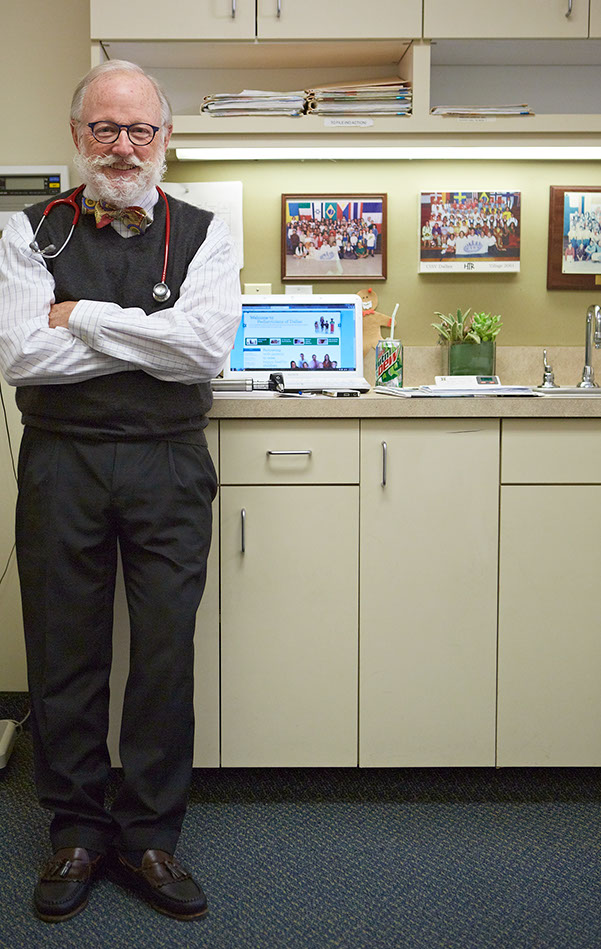
Background facts
Please share a little background industry info about you.
I'm a pediatrician in private practice. I also hold the title of president of my company, but in fact it's entirely run by the consensus of the four physician shareholders. I finished residency in July of 1979.
My dad was a doctor and my grandfather was a veterinarian and from the early stage it was what I felt I should do also. I’m glad that I like it; I more than like it,
I love it. And, I’m enormously flattered when someone says, “I want to be a doctor, just like Dr. Watkins.”
On becoming a doctor ...
When I see high school students who say they want to be a doctor, I tell them that it's a straight brightly lit path. There are no secret handshakes. You don’t have to be brilliant to be a doctor. You just have to be decided fairly early and don’t stray from the path.
You don’t have to be a science major, but you do have to take a lot of science. You have to take organic chemistry and make at least a B. You need to include just a little bit of good doing on your resume, and then the biggest hurdle is getting into medical school. If you live in Texas, you’re in good shape because we have several medical schools and there are lots of spots.
Jim initially wore bow ties just once a week, but patients starting asking him why he wasn't wearing one - so he simply adopted the bow tie as his part of his working wardrobe. In Britain, if doctors wear a tie - it's a bow tie for sanitary purposes.
"I hate to admit it, but I like shopping, even when I don't buy anything. It can be recreational, but it is more fun when you're looking for some specific something."
It's a good gig: there are a lot of ways you can be a doctor - all of which carry a certain amount of respect from the community. Very few people get rich being a doctor, and they don’t get much respect from other doctors if they do. Of course, you may not get rich, but it’s well remunerated.
You can work very hard or not so hard, you can have a job where you’re working with people all of the time or not so very much. You can do research, you can teach; it’s a great job. It’s not complicated, it’s just work. It’s very simple - just don’t screw up.
Because your father was a physician, was it pretty much assumed that you would also have a career in medicine?
There's this idea in a lot of families that the first-born son should do what their father did if it was a good thing to do. I think there's always some pressure to do that, and it's not bad if they're suited to it: my oldest daughter is a pediatrician in our practice, and it fits her perfectly. In my case it worked out really well.
Who or what has been a strong influence of your style?
My father wore baggy suits, but with a starched white shirt every single day. He was the only doctor, for much of my childhood in the town where we lived in west Texas. He was pretty much always on duty, if somebody came with an emergency, if there was an accident, or heart attack, or a baby to be delivered, that was it - there was no time off. At one point, he didn’t leave the town for five years.
My mother went to college and graduated with a degree in Chemistry and then became a med technician. She was from Sherman and went to Austin College, and then lived in Dallas independently before she married, which was a little unusual, unique among her friends. I think she always had some ambition to get out, to go places and do things. Her favorite thing was to drive to Fort Worth and go to Neiman’s. When she started to have some money to spend, that’s what she liked to do - buy clothes, dress nicely, and wear hats.
Did she have a particular way of dressing you?
If you look at those pictures from the 50s, everybody put their sons in little suits. You’ve watched Mad Men; they put their kids in little suits to look like their dads and dress them up especially Sunday morning for church; me too. When I was in junior high school, I went to Michigan State for six weeks for a National Science Foundation math and science program. I lived six weeks in a campus dormitory. It was the first time I’d ever been on a plane, and the first time I’d ever met so many smart people. It was threatening and also just terrific fun.
That experience gave me the courage the next summer to be an exchange student in Sweden for six weeks, and spend another two more weeks on the "If this is Tuesday it must be Belgium" tour. It was life changing and of course, in terms of style, everyone I saw dressed differently. I spent my junior year in England, and everyone was wearing skinny or tighter clothes, which was really fashion-forward compared to how people were dressed in Texas. I think every one of us on that trip bought some clothes that they couldn’t wear once they got home.
Dress code
What initially drew you towards the bow tie, and what has kept you there?
For a lark, I started wearing bow ties just on Friday about fifteen years ago. Before long, patients were asking, "Where's your bow tie?" so I started wearing them every day. In fact, wearing a bow tie is preferred by many doctors as it is less likely to be a source of infection and is out of the line of fire for things that might be messy (babies can be messy)! In Britain, I don’t know how strictly it’s enforced, but there are guidelines that say that doctors shouldn’t wear long ties.
I still have about 100 long ties in my closet. I still have the tie I was married in, 35 years ago. It is a nice tie.
Where do you shop for your work wardrobe? What are your typical go-to brands?
Orvis makes great shirts, no iron. I’ve worn Brooks Brothers for a long time because it was sort of standard - light blue, tiny checks, stripes, all those kinds of shirts. Great shirts. The problem is they wear out really fast, and become thread bare right around the cuffs and Orvis' just don’t. They are great for travel.
Territory Ahead is a good online store and catalog. And Kuhl makes tech style clothing, intended for hiking and mountain climbing, very comfortable - sort of nylon and snag free. For jeans, I only have Levi's.
I have a Barbour coat that the family gave me a couple of few Christmases ago and it’s a great coat. It is sort of heavy, but it’s waxed cotton and so it’s water repellent. You can wear them in town and they have become very popular in recent years. Mine was new, but you can buy vintage ones online because they just never wear out and there’s a certain cachet to having one that looks a little bit worn, not so brand new.
Right, not quite so crispy, shiny?
Right, because it’s a product that hasn’t changed in 15 years or longer. If you buy this particular brand, in this particular style, it’s exactly like the one you’d go in and try on in a store. I also have some Allen Edmonds shoes that I bought used, and they were fine - hardly been worn. I also wear Cole Haan moc style loafers that are well made, comfortable, and they last a long time.
And you shop on eBay?
Yeah, but it's difficult because you can’t inspect what you're buying, so it has to be something that you can try on in a store somewhere or that you know exactly what your size is and how it would fit. After I bought Allen Edmond shoes at Nordstrom, I was comfortable buying them on eBay because I knew the fit and my correct size.
Where do you buy your bow ties?
I have several ties that I've bought at Brooks Brothers in Yale and at the Dallas, Boston, and New York City locations. Nordstrom and Neiman's have lots of really cool ties; the problem is they are very expensive.
Online, I shop at TheTieBar.com. They have great ties for $15. Jesse Tyler Ferguson, the bow tie guy on Modern Family, has a line that supports marriage equality and Dwyane Wade also has a collection that has really fun pieces. Another site I like to shop is BeauTiesltd.com. They have great ties, although they are all $37, but they are really terrific as well.
When do you find the time to shop?
I hate to admit it, but I like shopping, even when I don't buy anything. It can be recreational, but it is more fun when you're looking for some specific something. I like consignment furniture stores, but I'm not a fan of malls.
I think it’s a fun thing to do. Plunging into a big department store in a major city, especially in another country, tells you a lot about their culture. Even if I don’t buy anything, I think it’s fun to see what’s cheap, and what’s expensive. If you go into the housewares department of a big department store, you get a feeling for the style of the place and you sort of understand
things better.
As for accessories, what type of wallet or money clip do you use?
I have a Bellroy thin wallet, but I have to resist the temptation to add more cards all the time. No wallet is thin if you load it up.
What’s on your wish list for this upcoming season’s wardrobe?
Lose 15 pounds. Just being honest.
What's the most important part of your grooming routine that you feel helps complete your look?
I'm not sure I have a look; certainly not one that's complete. Maybe my beard; it's white and curly, but not thick so needs a little tending. Still, once I leave the house in the morning, I don't look back.
What is your approach to jewelry?
Watch and wedding band. That's all one needs. Margaret gave me a Rolex about five years ago for our 30th wedding anniversary.
It’s nice.
It is nice; she bought it used.
Even better.
I started going through watches, even fairly nice watches, and they still didn’t last very long. It’s really modest, so to speak, except for the fact that if you notice it’s a Rolex, then you know that it was expensive. On the other hand it’s likely to last; you can wear it your whole life.
Your glasses are always special. Do you shift between wearing different frames?
Like most people who wear glasses, I find it useful to have two pairs in the current prescription and on a whim I change back and forth between Mikli and Armani. Stephen is the frame guy at the optician I use, L'Optique, and I'm not quite brave enough to wear everything he recommends - so we compromise.
Daily commute
By what means of transportation do you get to work?
I drive by myself in my faithful 2003 Suburban. It takes
15 minutes most days.
What color is it?
Red. We own three cars; all three are red. It really wasn't
planned that way, it just happened.
Do you have a favorite song/artist/playlist that you listen to on your way or during to work?
Nope. Just NPR news.
No music? I'm surprised.
Music is important to me. I enjoy making music. I've been a musician all of my life; as far as I can remember, but just listening to music doesn't always appeal to me. I think all my friends who are musicians find that odd, too.
What is your morning beverage & what type of container?
My brother says I drink diet antifreeze, but it's really Diet Mountain Dew, from the can, with a straw; then a coffee later in the morning.
Workday
What is your morning office routine?
About half the time I drive to a hospital to make rounds before
going to the office. The other half I start the morning in clinic.
On Wednesday's, I go to a lecture at Children's Medical Center
to start my day.
What does a typical workday look like for you?
After the hospital, I do what most pediatricians do: a series of appointments with children and adolescents, some with problems and some for their well care. There's a break of about 45 minutes at lunch, and the day usually ends at the office between 5:30pm and 6:30pm.
The docs in my group exchange texts each night, the doctor on call assigning the doctors for the morning hospital rounds and on Fridays, the one to pick up the TGIF breakfast snacks for the office staff. We've had Friday morning treats every Friday since the practice started in 1999. We have a great staff and we try to let them know it.
Do your morning rounds at the hospital occur before you start seeing your patients in your clinic? Are they like wee early hospital morning hours?
It can be pretty early. For example, there are usually two docs to see patients in the clinic on Saturday mornings, which starts at 8:30am. When it's crazy busy, there can be sixteen to twenty babies at the hospitals to see before the 8:30am clinic start time, so we're knocking on hospital doors at 6am or earlier.
Do you have seasons or certain times of the year where things are simply busier?
Yes, and it's very pronounced in fact. The two weeks before school starts are super busy with parents getting school forms all filled out; and hospitals will tell you their busiest months for delivering babies are August and September; nine months after the holidays.
Winters are always busier; particularly December, January, February. Kids are sick - respiratory illness particularly. If it's the week before Christmas, then there's another 15 percent of people who want to come in, because of upcoming holiday trips - ski vacations, trips to visit Grandma. Nobody wants to get sick during the holidays.
We try to prepare the office for these busier periods by reviewing what the patient traffic looked like last year. Based on that information, we determine schedules that we hope will keep visits running smoothly for everyone.
What essentials do you have when you meet with patients?
When I teach in the Medical Student Clinic at CMC, I tell a story about a teacher I had who asked our group of medical students, "what is the most important thing to have when you see a patient?" We all had reasonable answers, but none of us had his: a chair. Think about it.
To get the best history, you need to sit down and pretend you have all of the time in the world. You want to hear what they have to tell you; why they've come.
How do you handle job-related stress?
Sometimes I plunk on the piano late into the night, sometimes
I veg in front the computer, sometimes I drive my 1965
vintage MGB (when it will start).
What is your happiest moment at work?
It is intensely rewarding to watch the children I see grow up.
I like to think - and am sometimes affirmed to believe - that I
played a role in their success. I can't claim much credit, really,
but it's nice just the same. I have a great job.
Desk drawer
How would you describe your office space?
It is functional. It is usually messy, but since straitening it up, now it's simple and efficient. There are pictures of CISV groups, which mean a lot to me, and a gingerbread man that's supposed to resemble me. Makes it feel like my space.
Are you a messy guy? I thought of you as a neat freak.
Margaret [Jim's wife] would say that I'm definitely not a neat freak. On the other hand, I do safety pin my socks together when I take them off at night - that way they don't lose each other in the laundry. They come out of the dryer already paired together.
What is in your office, that makes it more comfortable for you to be in everyday?
We have a small conference room, mostly unused, where one can retreat to play computer solitaire or bridge (an addiction for me, though I play with live people rarely), but my workaday desk is in an open hall and pretty spare.
How do you organize your workstation?
Five slots: In Now, In Sometime, Mail, Out for Attention Now, and Out to be Filed. And the most used: Trash.
What is your favorite office supply and why?
My pen. Uni-ball, micro point, and blue; that, and 3x5 index cards.
What's a work tool (app/hardware/software) that’s a must have?
My iPhone and Evernote.
Agenda
What is your secret to achieving your daily objectives?
1. Pretend you're happy and you will be (mostly) and 2. Plod on.
How do you organize and maintain your to do list?
I always carry 3 by 5 index cards in my shirt pocket. I make lists, take notes, leave reminders, etc. with these and go through them for things I meant to do several times a week. It's a long time habit.
I love the fact that you like Evernote.
It's on everything we do. I think you could get to know somebody by looking at their Evernote.
I have 176 notes, and they're in chronological order just from newest to oldest. I sort of know where they are, because I've never sorted them and I don't tag them. I have CISV notes, our reservations in Jackson Hole where we're going next month to fish and go to Yellowstone, the schedule for this office of who's available each day, and here's a recipe for crab cakes and hot sauce. This note just says "Red Breast Whiskey," because somewhere I read you should buy some of this, so I will. One of the Uber drivers who drove me in Cincinnati gave me a code that would be good for a $10 discount, so I added it in a new note.
Are you a premium user on Evernote?
Yes, absolutely. Here's a recipe for pumpkin biscuits, Betty' Brashier's chocolate cake, Ina Garten's chocolate cake recipe, coconut cake from Julianna Crownover (that's really good), and Louisa's [one of Jim's daughter's] baby ultrasound. My Montana fishing license ...
What is your work motto?
Remember, this is fun.
Downtime
What do you do during your downtime to refresh and recharge?
I don't watch too much TV, but it's all British. I even pay for
access to BBC TV on my computer. Or were you asking about
gin (the beverage, not the game)?
You are funny. But you are also a big foodie.
I like to cook and I appreciate really great food. We recently
went to the only Michelin three-starred restaurant in Brussels;
one of those once in a lifetime moments.
Do you have favorite websites?
Yes, BBC News. My homepages are BBC news, eBay and Woot.
Woot. Funny.
You hardly ever buy anything you really need. My wife has a box full of Woot purchases that we actually have no use for. I bought something last week on Woot for my phone, but it doesn't fit. I must not have read the specs.
Do you read much?
My wife does. I subscribe to The New York Times. I have a daily subscription.
How important has traveling been for you personally?
I traveled a lot when young, as did my wife and we've traveled more recently. We both spent a full year abroad in college and it changed us. We have encouraged our children to travel and they have been fortunate to do so. Our youngest went around the world twice in one year, first going west, then going east.
Ever hear of Trusted Traveler? It's that card where you don't have to go through customs and immigration, and you can skip the TSA lines. You have to go through an interview process and there is a cost for it, but it is worth it. The line you wait in is the one for crew and diplomats.
What currently fascinates you and has your interest?
For several years I've been involved with CISV, an international peace organization, sanctioned by the UN, that seeks to give young people perspectives about the world at large, especially as to how they differ and yet are kin. I'm a national board member now and have been involved with the DFW chapter for a long time. We can't change the world overnight, but we should do what we can. Think how much the cause of human rights and justice issues has progressed in just the last three generations!
The organization started in 1950 with a woman named Doris Allen in Cincinnati, who was the Professor of Psychology at the University of Cincinnati. She was in New York, sitting on a park bench in Central Park, when she read in the New York Times that the UN (which was quite new in 1950 - war was barely over; they were still rationing food in Britain) was organizing a symposia for twenty-somethings from countries all around the world to get to know each other, with the object being world peace.
Her immediate reaction was, "The twenties are way too late - we should do something with younger kids." She knew lots of psychologists around the world, and she organized a month-long summer a camp in Glendale, Ohio with about forty children from 8 different countries. That was the first camp. Now every year there are between 50 and 60 camps like this somewhere in the world. CISV is in 70 countries. There are over 200 chapters all together, 21 in the United States.
Doris died in 2002 at the age of 101. Her idea was to influence the children who would be the leaders of tomorrow. They might not be national leaders, although now a number of people who are CISV Villagers have become members of the House of Representatives of the United States, and one became the Prime Minister of Japan. The idea was if you could get children to understand each other and to see how their own view of the world may not be like everyone else's and may not necessarily be the best for everyone, that you would go a long way toward world peace. Let's not drop bombs on our friends.
Jim with his adorable 2-year-old granddaughter, Dottie.
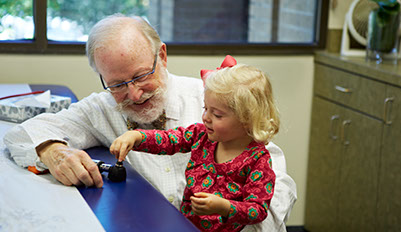
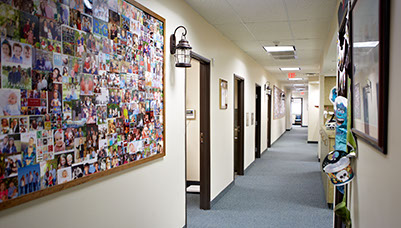
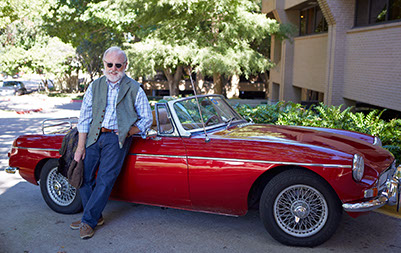
Jim and his fun 1965 MGB, which was his reward for conquering cancer - twice!
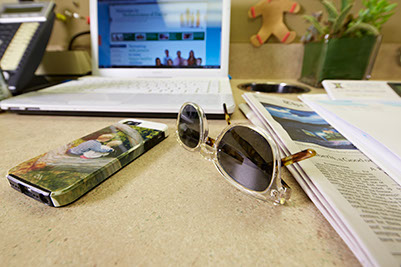
Jim's iPhone case is an image of his grandchildren. His sunglasses are by Robert Marc.
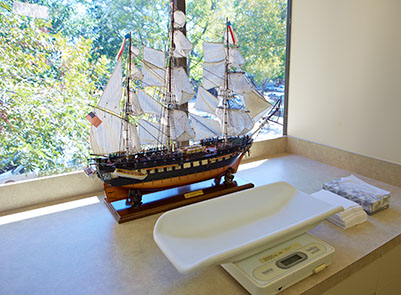
How to tie a bow tie
Follow Jim's example to see how "simple" it is:
1. When starting, make sure the right side is a little
longer than the left side.
2. Cross ends (long over short).
3. Fold the longer end up through the center (under
the shorter end).
4. While holding the longer end straight up, fold the
shorter end horizontally.
5. Then bring the longer end back down over the
shorter end.
6. Fold the longer end horizontally and bring it
through the inside loop (behind the shorter end).
7. Solidify the knot for the bow by giving each end a
gentle, final tug.
Additional insights for bow tie newbies:
1. A butterfly tie is easier than a straight tie to begin
learning, because the center of the "bow" on each
side is more defined.
2. If you are showing someone how to tie a bow tie,
stand beside them (not facing the student) in front
of a mirror - so that they can copy what you are doing
more easily.



















<
>


